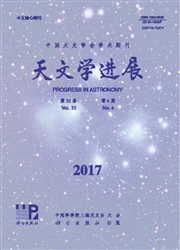

 中文摘要:
中文摘要:
弱引力透镜形变信号的测量需要精确的图像处理,因为信号本身非常弱,椭率变化大小只有干分之几的强度,是其星系本身的内禀椭率形状噪音的几百分之一,需要叠加至少约1000幅图像才能从星系图像中得到信号。此外,观测设备的光学效应、大气扰动和CCD的像素化效应(点扩散函数1是图像处理的首要系统误差。怎样改正点扩散函数(PSFl的系统误差是弱引力图像处理的第一步,也是最重要的一步。首先详细介绍了引力透镜的基础理论和弱引力透镜作为其分支领域的特点。其次,介绍了基于重高斯化和圆化卷积核方法的图像处理管线的建立,利用Mandelbaum等人的图像模拟软件,将COSMOS的高分辨率空间图像变成低分辨率地面SDSS图像。最后,检验结果表明,对于一个椭率约为0.05的可加PSF系统误差,经过修正后,只有10^-4量级的残余;而PSF的另一个可乘系统误差则修正到1%以下。
 英文摘要:
英文摘要:
Weak lensing measurement requires accurate image processing due to the weak signals at 0.1% level. As galaxies themselves have intrinsic shapes which are hundreds times stronger than the signals, we have to apply stacking technology to get the signals by assuming an isotropic distribution of the intrinsic shapes. Moreover, the optical Airy disk together with atmospheric seeing may dilute the signals and introduce coherent false signals. Among these difficulties, the most important step in weak lensing measurements is to properly correct for the PSF effect. In this paper, we first present the basic theory of weak lensing and the method to measure the tangental shear. Then we discuss in detail the systematics that can be induced by PSF and the methods to correct for this. Here, we built our own image processing pipeline based on two methods and tested it using Mandelbaum et al. 2011 software. The testing results show that our pipeline meets the required 〈1% level systematic error if the PSF is perfectly known. Finally, we give our summary and prospect on the future gravitational lensing studies.
 同期刊论文项目
同期刊论文项目
 同项目期刊论文
同项目期刊论文
 Cosmological constraints from a combination of galaxy clustering and lensing - II. Fisher matrix ana
Cosmological constraints from a combination of galaxy clustering and lensing - II. Fisher matrix ana RECONSTRUCTING THE INITIAL DENSITY FIELD OF THE LOCAL UNIVERSE: METHODS AND TESTS WITH MOCK CATALOGS
RECONSTRUCTING THE INITIAL DENSITY FIELD OF THE LOCAL UNIVERSE: METHODS AND TESTS WITH MOCK CATALOGS Cosmological constraints from a combination of galaxy clustering and lensing - III. Application to S
Cosmological constraints from a combination of galaxy clustering and lensing - III. Application to S Cosmological constraints from a combination of galaxy clustering and lensing - I. Theoretical framew
Cosmological constraints from a combination of galaxy clustering and lensing - I. Theoretical framew Reconstructing the cosmic velocity and tidal fields with galaxy groups selected from the Sloan Digit
Reconstructing the cosmic velocity and tidal fields with galaxy groups selected from the Sloan Digit Ages and metallicities of central and satellite galaxies: implications for galaxy formation and evol
Ages and metallicities of central and satellite galaxies: implications for galaxy formation and evol GENUS STATISTICS USING THE DELAUNAY TESSELLATION FIELD ESTIMATION METHOD. I. TESTS WITH THE MILLENNI
GENUS STATISTICS USING THE DELAUNAY TESSELLATION FIELD ESTIMATION METHOD. I. TESTS WITH THE MILLENNI Nonlinearities in modified gravity cosmology: Signatures of modified gravity in the nonlinear matter
Nonlinearities in modified gravity cosmology: Signatures of modified gravity in the nonlinear matter 期刊信息
期刊信息
